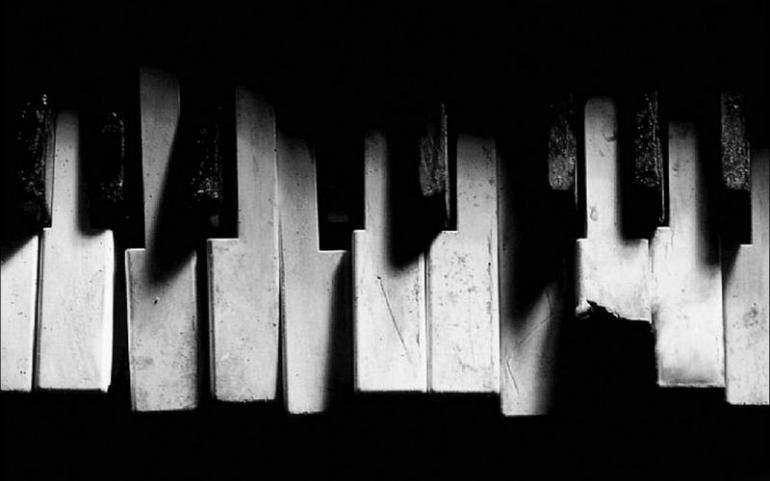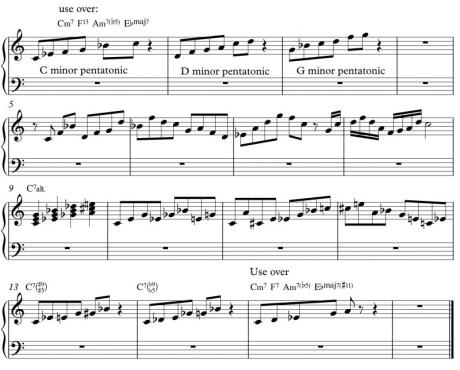Rockové klávesy - Síla překrývajících se pentatonik
Welcome readers. This month I wanted to give you a few interesting tricks using simple pentatonic scales and a few triads to spice up your solos. Pentatonic scales are simple and many players have them under their fingers. Our techniques in this month’s lesson will just show you a few ways of combine them to create interesting lines for soloing.
Three overlapping pentatonics for automatic lines

The main building block in our first example is a very simple minor pentatonic scale (1, b3, 4, 5, b7, 1). In this system, we choose three pentatonic scales that all exist in a mode, in this example, C dorian (C, D, Eb, F, G, A, Bb, C). In bars 1-4, you will see three minor pentatonic scales C, D, and G. What we are going to do is quite randomly switch between the three going up and down the keyboard. Interesting intervals are automatically created without us even thinking about it if we switch quickly between the three scales. The only thing we have to think about is the starting note of the pentatonic; in this case the scale degrees I, II, and V of C minor. In bars 5-8 I’ve given you an idea of what this looks like. Also because the C dorian scale works over quite a few chords, you can use this idea over F13, Am7/b5, and Ebmaj7 chords.
The symmetry of diminished harmony
I wanted to give you another trick to use the next time you are soloing over a one chord vamp; symmetrical triads from the diminished scale. In this exercise we take a C triad and transpose it up a minor 3rd, take that triad (Eb) and move it up a minor 3rd, and so on. The scale created by the notes in these triads is a C diminished scale (C, Db, Eb, E, F#, G, A, Bb). Because of the symmetrical nature of this scale, which splits the octave into 4 key centers, lines made from this technique sound very modern and work great in the middle of a blues based solo for a different color. Bar 9 shows you the 4 triads we are using and bars 10-12 shows you the theory in action.
Altered pentatonics
Here are a few examples of some altered pentatonics; meaning pentatonics that have a few notes changed to make interesting sounds. Bar 13 has a great C7 altered pentatonic that sounds great on a one chord vamp. Notice that the scale (which actually has six notes so it’s not technically pentatonic) has a major and minor third. This makes the tonality a little mysterious and can add great tension to a solo when used correctly. This scale also has a chsr15 sound (G#). Bar 14 has an alternative version of this scale with b9 and b5 alterations (Db and Gb). Bar 15 has a minor 6 pentatonic that adds yet another colour. This scale is also from the C dorian mode and can be used over quite a few chords (Cm7, F7, Am7/b5, Ebmaj7).
FRÁZE A HUDEBNÍ TERMÍNY:

Over lapping pentatonics: Pentatonické (pětitónové) stupnice, které se vzájemně překrývají.
Quite a few chords: Člověk méně znalý anglického jazyka by si nemusel všimnout, že existují dva podobné výrazy: vedle „few“ narazíme často na „a few“. Ten nenápadný neurčitý člen přitom zcela mění význam. Zatímco „few“ používáme ve významu „málo“, „a few“ znamená spíše několik. Když pak frázi rozšíříme na „quite a few“, znamená to něco jako „pěkných pár“, tedy vlastně mnoho. Kdo by to byl řekl, že „few“ a „quite a few“ jsou de facto vzájemně opačné výrazy
One chord vamp: Na výraz „vamp“ už jsme kdysi narazili, ale pro jistotu: Jedná se o termín oblíbený obzvláště v jazzu, kde je jím označován improvizovaný doprovod, který však vychází z jasně daného motivu či riffu. Narazil jsem na tvrzení, že se většinou objevuje v předehře či naopak v závěrečné části, ale dle mé zkušenosti můžeme mluvit o “vampu“ pokaždé, když má sice instrumentální doprovod (nejčastěji hraný na klavír) jasnou harmonickou (a rytmickou) strukturu, ale v jejím rámci má hudebník určitou svobodu a může ji průběžně do určité miry obměňovat. „One chord vamp“ je tedy doprovod motající se kolem jednoho akordu.
Symetrical triads: Z minulých dílů už víme, že „triad“ znamená „kvintakord“, ale co má Brian na mysli, když píše o symetrických trojzvucích? Jednoduše řečeno to znamená, že mezi prvním a druhým tónem je stejný interval jako mezi druhým a třetím. Technicky vzato existuje pouze jeden typ symetrického trojzvuku - zvětšený kvintakord. Jeho obratem vznikne opět zvětšený kvintakord, takže vlastně nemá smysl mluvit o obratech. Dalším symetrickým akordem je zmenšený septakord, který je však už čtyřtónový. Symetrickou povahu má také zmenšená stupnice, které se Brian v tomto článku věnuje.
Add great tension: Tato fráze znamená doslova „dodat velké napětí“. Střídání napětí a uvolnění lze považovat za jeden ze základních principů hudby. Jako opak slova „tension“ se v hudební terminologii používá „resolution“, což doslova znamená „řešení“, ale je dobré výraz chápat spíše jako „uvolnění napětí“.




